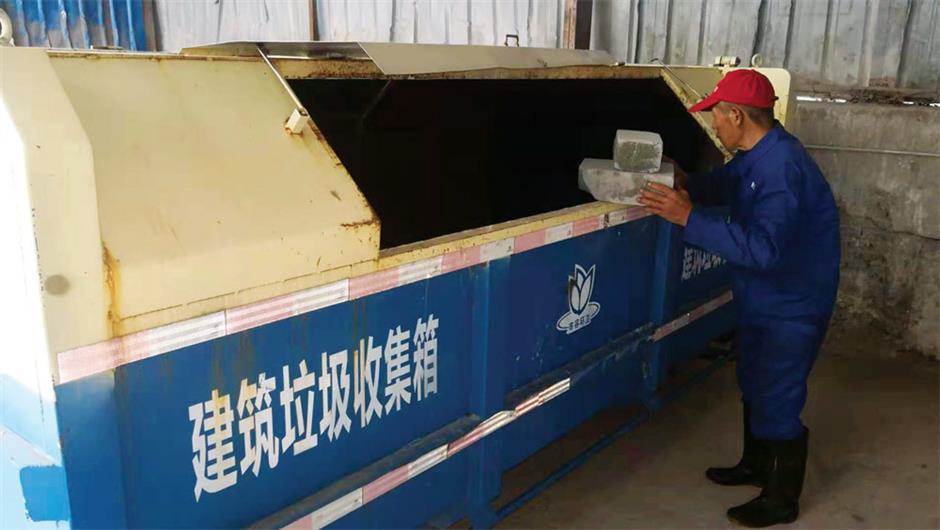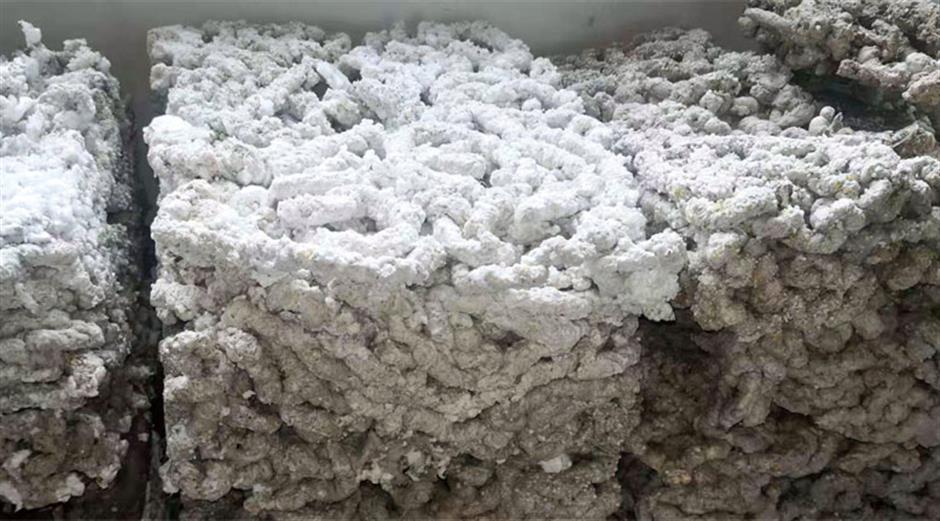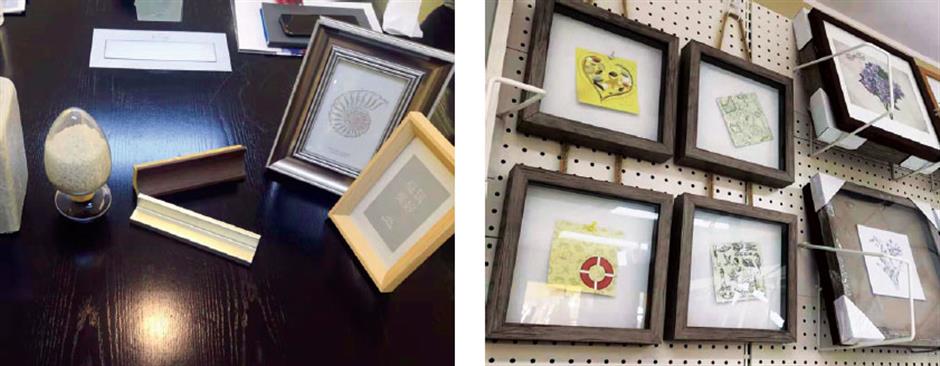
A sanitation worker takes construction garbage that can be recycled from a collection bin in Fengxian District.
Recycling in neighborhoods is moving apace and works well when trash is a manageable size. But larger rubbish, like construction debris, renovation discards and foam plastics are typically destined for incineration.
However, some districts are exploring new ways to turn this trash into treasure.
“We are talking about big waste that is difficult to dismantle and recycle,” said Huang Jianguang, an official with the Fengxian District Public Sanitation and Environment Management Station.
In the Fengxian District, foam plastic waste is recycled for use in painting, photo and mirror frames and decorative moldings.
Shanghai Qunxin Municipal Administration Development Co is in charge of dealing with problematical trash in the district’s Nanqiao Town.
Collected foam plastic waste is put into a compression machine. The heat and pressure reduce every 90 cubic meters of waste into 1 cubic meter of recyclable product.
“Foam plastic waste is priced at less than 1 yuan per half-kilogram, so most garbage collectors don’t want to bother,” said Huang. “In addition, the size of the waste doesn’t usually fit into neighborhood recycling bins. It’s often just tossed to the side, ending up in incineration.”
 Hu Min / SHINE
Hu Min / SHINEFoam plastic waste will be used as materials for painting, photo and mirror frames and decorative moldings after being compressed.
Once recycled, foam plastics fetch up to 6,000 yuan (US$862) per ton.
At Shanghai Intco Industries Co, recycled foam plastics are further processed into polystyrene particles, which can be made into exquisite paintings, photo and mirror frames, and decorative moldings through manufacturing and assembling. The most expensive frame is priced at nearly 20,000 yuan per ton and is exported overseas.
Intco operates in Shanghai and five other cities. It collects about 50,000 tons of foam plastics every year, converting them into 1.2 million boxes of decorative molding.
The molding has the look of marble or solid wood after surface coating and is quite waterproof. It can be used in place of standard products marble or solid wood. In the latter instance, it can save trees, according to Intco.
The company’s sales from recyclable foam plastic products top 200 million yuan a year.
Though these efforts are proving successful, a recycling industrial chain for waste foam plastics in Shanghai is still rare. Intco still has to import a large volume of recycled foam plastics.
“The root lies in waste sorting,” said Huang.
Many communities and work units in Fengxian do not sort foam plastics as a single category of recyclable material, he said.
 Hu Min / SHINE
Hu Min / SHINEFrames made from recycled foam plastic waste
“Foam plastics are polluted once they are mixed with other garbage,” he explained. “Sometimes, disposable foam plastic dishware is dumped into bins used for household food waste, or wet garbage, with food left inside.”
The purity of polystyrene particles processed from such polluted foam plastics is low, creating a product pretty worthless on the market, Huang said.
“Given factors like logistics costs, we are eager to get sorted waste foam plastics from nearby residential communities and work units,” said Jiang Hongfang, assistant of general manager of Shanghai Intco.
Fengxian is tackling the problem.
Twelve sorting sites for construction debris, one in each town in the district, will be installed, with machines that can compress the plastics subsidized by the district government. The end product will be supplied to companies like Intco after treatment, Huang said.
“Making the public realize the value and purpose of garbage sorting will encourage their participation in waste classification,” said Xu Zhiping, director of the environmental sanitation department of the Shanghai Greenery and Public Sanitation Bureau.
Proper garbage sorting also raises the value of waste, he added.
Some residential complexes in Fengxian are now in trial projects related to garbage sorting.
At the Wanghai Xindu and Miaojing residential complexes, interior decorating companies must register with property management companies and pay a deposit before they can work in the communities. If they don’t sort trash such as foam plastics, flooring, sofas and mattresses at designated sites, they face warnings and then forfeiture of their deposits. They may also be banned from working in the communities.
In Jinshan District, authorities discovered that the debris of home decorating, such as discarded furniture, was rejected by waste collection stations because the trash was too big to dismantle and too difficult to transport.
Specific treatment facilities targeting big garbage are inadequate in Jinshan, officials said. Treatment hasn’t caught up with demand, resulting in a rapid rise of problematical garbage, according to the Jinshan District Greenery and Public Sanitation Bureau.
The bureau will create 11 sites for dismantling and recycling such trash in towns and industrial zones.
Shanghai is embarked on a long-running campaign to address its mounting volumes of trash. Recycling is the watchword when materials can be sorted, collected and treated for reuse.
The city plans to fully implement a domestic garbage-sorting program by 2020. A draft of the regulations was reviewed by the Shanghai People’s Congress in September.
The regulations cover all the processes in the garbage chain — from dumping and collection to transportation and treatment.
Companies and factories will be required to adhere to clean production methods and use eco-friendly manufacturing technologies, according to the draft.
There are currently 1,475 collection sites for recyclable wastes in the city.
